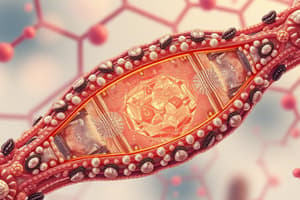Podcast
Questions and Answers
Which scientist first observed the phenomenon of electrophoresis?
Which scientist first observed the phenomenon of electrophoresis?
- Albert Einstein
- Marie Curie
- Ferdinand Frederic Reuss (correct)
- Isaac Newton
What determines the speed of movement during electrophoresis?
What determines the speed of movement during electrophoresis?
- Volume of the fluid
- Temperature of the fluid
- Magnitude of the charge (correct)
- Color of the particles
Which biopolymers can be separated and quantitated by electrophoretic methods?
Which biopolymers can be separated and quantitated by electrophoretic methods?
- Proteins and nucleic acids (correct)
- Enzymes and hormones
- Lipids and carbohydrates
- Vitamins and minerals
What is the main application of electrophoresis?
What is the main application of electrophoresis?
Which type of gel is commonly used for proteins?
Which type of gel is commonly used for proteins?
What is the range of separation for DNA fragments in agarose gels?
What is the range of separation for DNA fragments in agarose gels?
What is the most common gel media used today?
What is the most common gel media used today?
What is the purpose of the DNA loading dye in agarose gel electrophoresis?
What is the purpose of the DNA loading dye in agarose gel electrophoresis?
Which of the following statements about ethidium bromide (EtBr) is true?
Which of the following statements about ethidium bromide (EtBr) is true?
Which buffer is commonly used for routine DNA agarose gel electrophoresis?
Which buffer is commonly used for routine DNA agarose gel electrophoresis?
What is the purpose of pulsing the electric field in pulsed-field gel electrophoresis (PFGE)?
What is the purpose of pulsing the electric field in pulsed-field gel electrophoresis (PFGE)?
What is the separation principle of SDS-PAGE based on?
What is the separation principle of SDS-PAGE based on?
Which ions are present at a higher concentration in the double layer near the wall?
Which ions are present at a higher concentration in the double layer near the wall?
What is the overall solvent movement called when counterions migrate towards the cathode under an electric field?
What is the overall solvent movement called when counterions migrate towards the cathode under an electric field?
How can the electroosmotic flow be controlled?
How can the electroosmotic flow be controlled?
What is the apparent mobility in electrophoretic separation determined by?
What is the apparent mobility in electrophoretic separation determined by?
Which of the following is the correct definition of electrophoretic mobility?
Which of the following is the correct definition of electrophoretic mobility?
What are the units of electrophoretic mobility?
What are the units of electrophoretic mobility?
What is the principle behind electrophoretic separations in a gel?
What is the principle behind electrophoretic separations in a gel?
What is the relationship between electrical mobility and the net charge of a particle?
What is the relationship between electrical mobility and the net charge of a particle?
Which of the following is true about SDS-PAGE gel preparation?
Which of the following is true about SDS-PAGE gel preparation?
Why are there two layers of gel in SDS-PAGE?
Why are there two layers of gel in SDS-PAGE?
What is the purpose of Coomassie Blue staining in SDS-PAGE?
What is the purpose of Coomassie Blue staining in SDS-PAGE?
What is the most sensitive method for detecting total protein in SDS-PAGE?
What is the most sensitive method for detecting total protein in SDS-PAGE?
Which chemicals can cause chemical crosslinking of proteins in the gel matrix, limiting compatibility with downstream analysis by mass spectrometry?
Which chemicals can cause chemical crosslinking of proteins in the gel matrix, limiting compatibility with downstream analysis by mass spectrometry?
What is the isoelectric point (pI) of an amino acid?
What is the isoelectric point (pI) of an amino acid?
What is the general relationship between the isoelectric point (pI) and the charge of a protein?
What is the general relationship between the isoelectric point (pI) and the charge of a protein?
What happens to an amino acid at its isoelectric point under an applied electric field?
What happens to an amino acid at its isoelectric point under an applied electric field?
What is the purpose of creating a pH gradient in the gel in isoelectric focusing?
What is the purpose of creating a pH gradient in the gel in isoelectric focusing?
What are carrier ampholytes?
What are carrier ampholytes?




